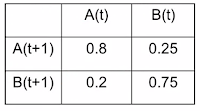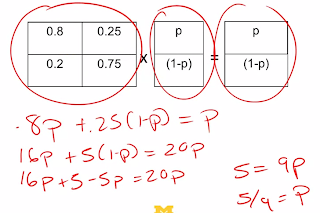Section 5 - Modeling People
Thinking Electrons: Modeling People - Part 1
Purposeful Actors
Diversity
Rational Actor Models - Part 2
- Assumes that people optimize their goals
- Assumes an objective function (happiness, market share, votes, etc), then they optimize
Start w/ an Objective ==> Optmize (i.e. maximize profit for a copmany, maximize utility for a person, political candidate get as many votes as possible)
revenue = Price x quantity
Qauntity = q, price = 50-q
What q maximizes the revenue
Decision - Objective only on what I do
Game - my payoff is dependent on others in the game. My payoff is decided by the action of others.
Normal Form Game
 |
| Model for 2 people going to the city or staying at home |
In the case above, if person 1 stays at home they get a payoff of 1, regardless of person 2. If person 1 goes to the city, they automatically get a payoff of 2.
For person 2, if they think person 1 is going to be rational, they should assume that person 1 will go to the city
Extension Form Game
 |
| Extensive Game Tree |
Green person will decide to go with the 0,0, as if blue is rational then they will optimize and go after 3, if offered a choice.
When will we see rationality:
- When stakes are large.
- When things are repeated
- When groups make decisions
- When the problem is easy
Rational assumes:
- Unique
- Easiest
- People Learn
- Mistakes Cancel out and you are left w/ rational
Behavioral Models - Part 3
- Gather real data, then model people as close to how real people behave
- Observe what people do, then find out that they are not rational, but they typically fit into some behaviors
2 books about how we add bias to our decisions
Daniel Kahneman - Book - Thinking Fast and Slow
Richard Thaler - Book - Nudge
1. Prospect Theory - Decision based on having a known amount offered, but they will sometimes prospect. We are risk adverse if the known amount is positive. If the decision for negative amount first, then people will take the risk on b
2. Hyperbolic Discounting - Option A a $1000, wait until tomorrow $1005. Short periods of time we won't tend to want a minimal increase. We tend to allows ourselves to wait for a somewhat larger amount.
3. Status Quo Bias - we naturally want to keep the status quo,
4. Base Rate Bias - If you ask someone for a number, then ask them for a second number, they will tend to be closer
Problems w/ Biases
1. Lots of Biases
2. WEIRD - Western Educated Industrialized Rich Developed Countries - Most biases are based on these categorized.
3. People Learn and can avoid
4. Biases can make things computationally difficult.
We want to consider which Biases have the most influence on the answer.
Rule-Based Models - Part 4
- Assumes people follow rules
- Schelling Model - example of a rule-based model
The matrix above is defines the various types of Rules-Based Models
We will walk through all 4 types
Fixed Decision Rule - may not be optimal
- Random decision choice
- Taken the most direct route - travel the most direct route -
Fixed Game
- Divide Evenly
- Tit for Tat - If you're nice, I'll be nice, etc. (Moore Machines)
- Grim Trigger - if you are mean to me, I won't ever get over it.
Adaptive Decision Rule
- Gradient method - I start by adding a certain amount, then slowly increasing until they start to get a little worse.
- Random - I could randomly throw something in.
Adaptive Game/Strategies
- Best Response - what is best possible response I can offer.
- Mimicry - copy people who are doing well
Observation #1
- Sometimes optimal rules are simple
Observation #2
- Simple rules can often be exploited
So Why Model
- they are easy to model
- capture main effects
- some of these models are ad-hoc, rules may not be representative
- sometime rules can be exploited.
When Does Behavior Matter?
- Rational
- Behavioral
- Rules-Based
Deciding which one is best to use or if it even matters
Market - Two Sided (Buyers and Sellers)
Buyers have prices between $0 and $100
Sellers are willing to sell between $50 and $150
If you are the buyer you will start your price below, if you are a seller you will ask for a little higher than you would like.
Relevant buyers will want to buy between 50 & 100
Relevant sellers will have to sell between 50 & 100
rational will say about $75
optimizing won't change it much, so it will be about $75 again
Rules-Based again if you model you will likely find something around $75 again.
The market will not really change the model behavior
Game - Race to the bottom
Pick a number from 0 to 100, the person closest to 2/3rds of the mean will win
Rational would push us towards 0
Behavioral will ....
If you applied rules then you would be biased toward 50, then the best reponse is 2/3rds of 50 is 33, that should be my guess.
Irrational people will change things in this case.













